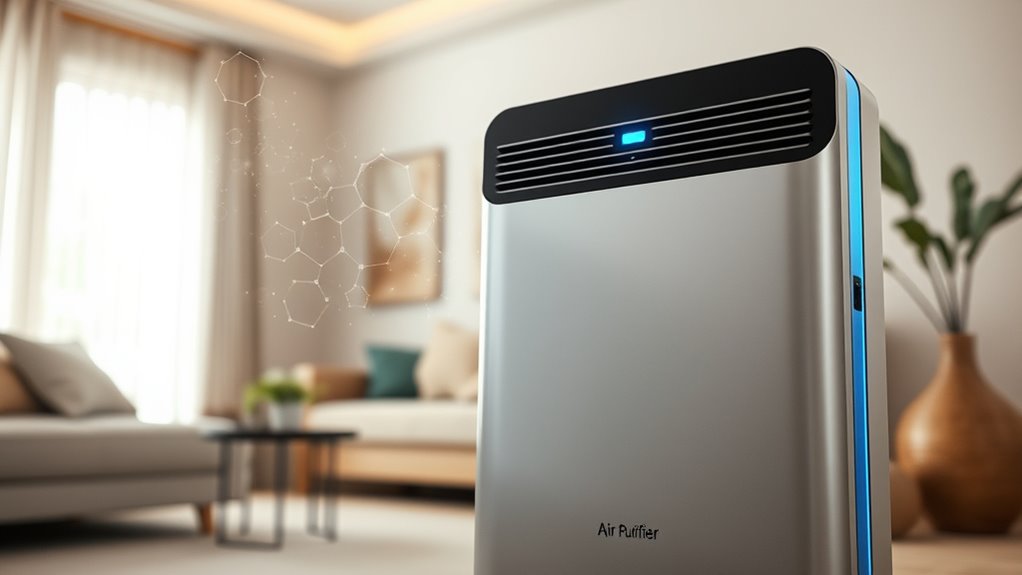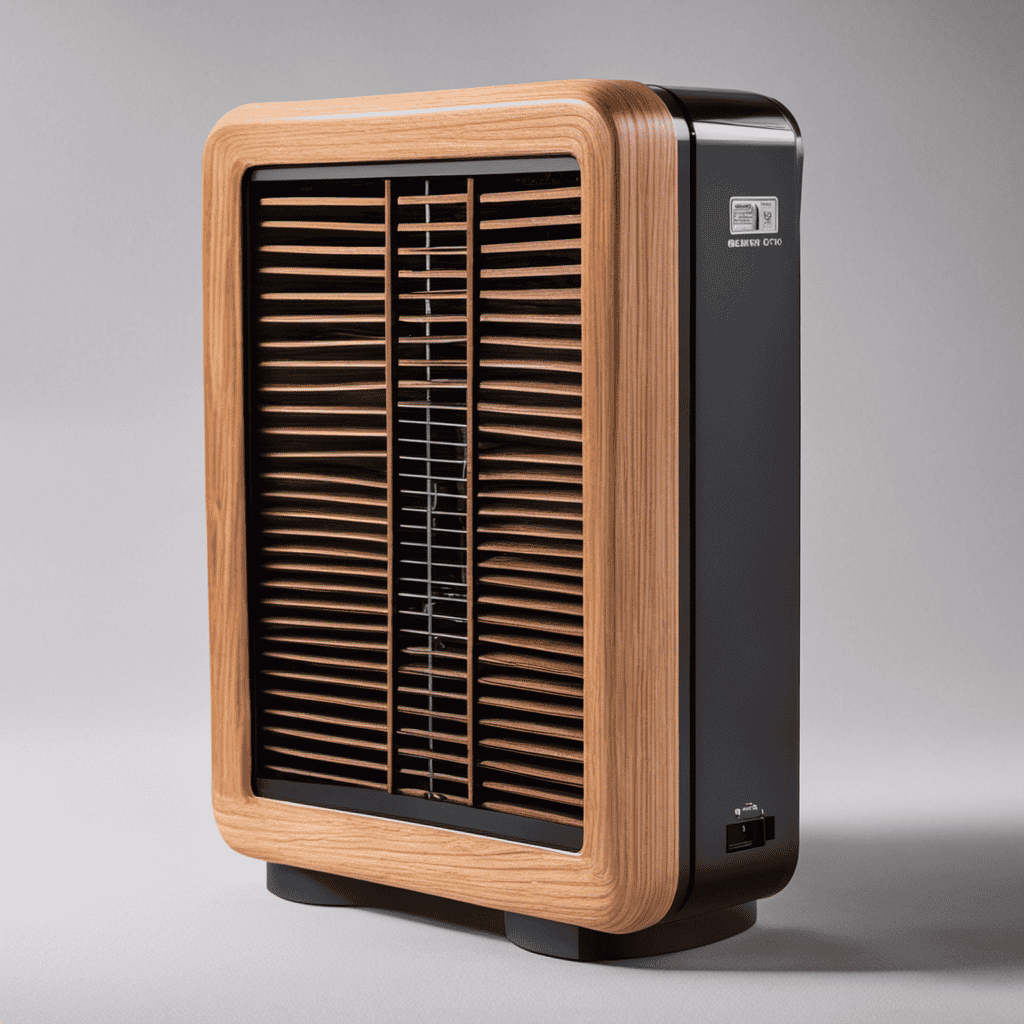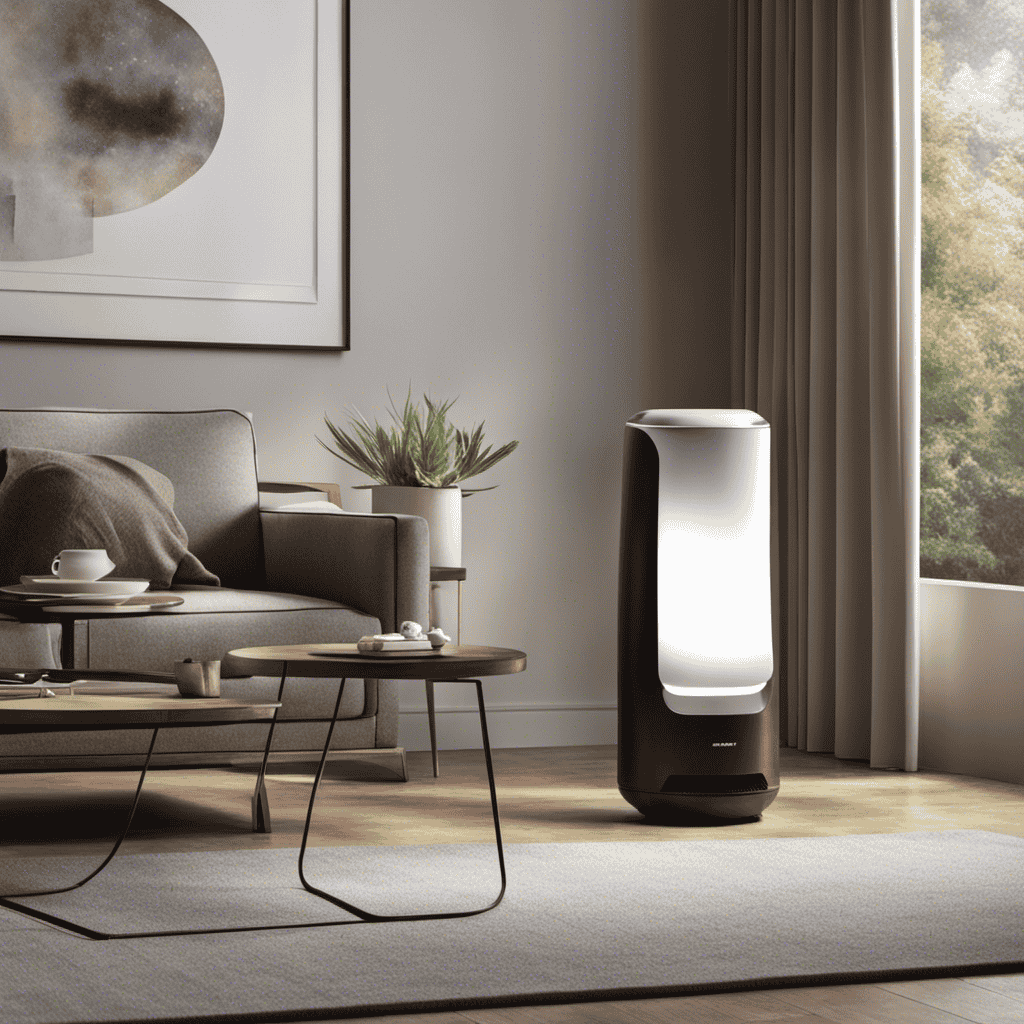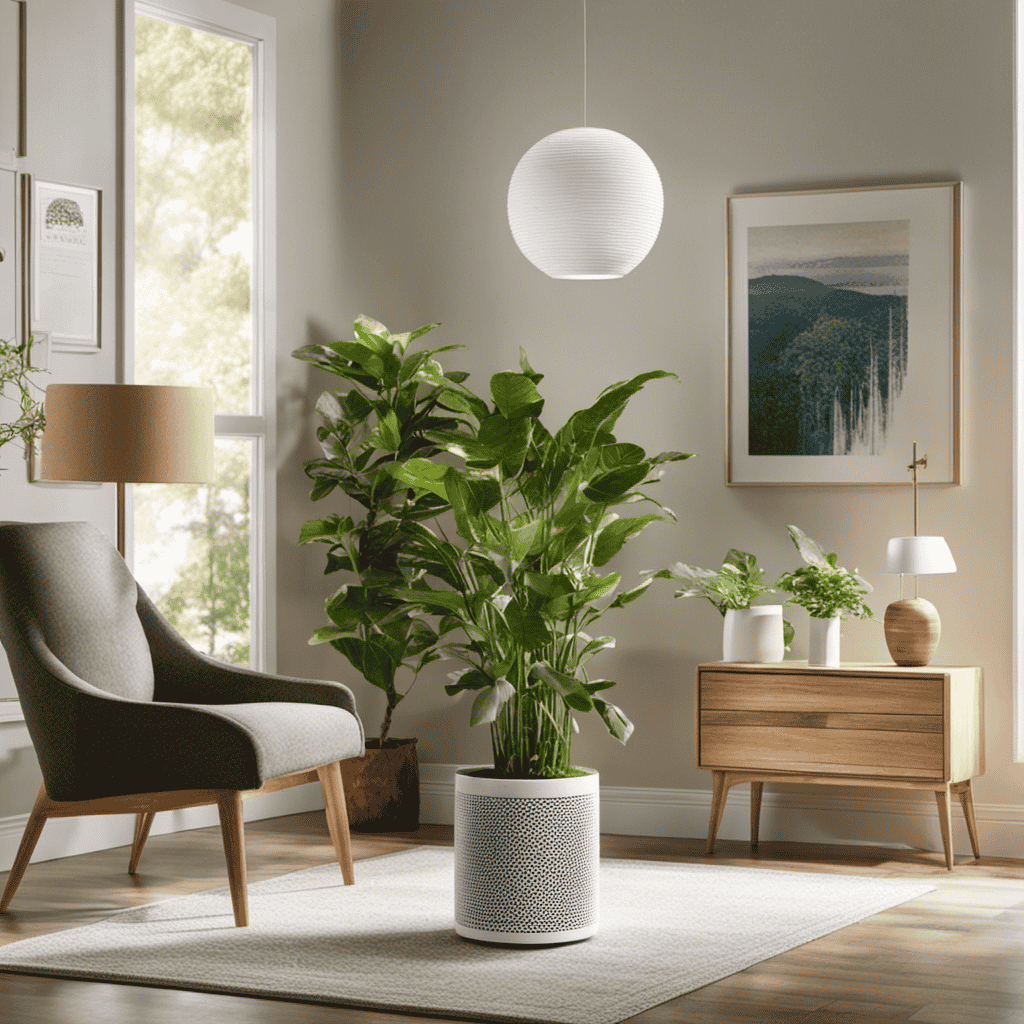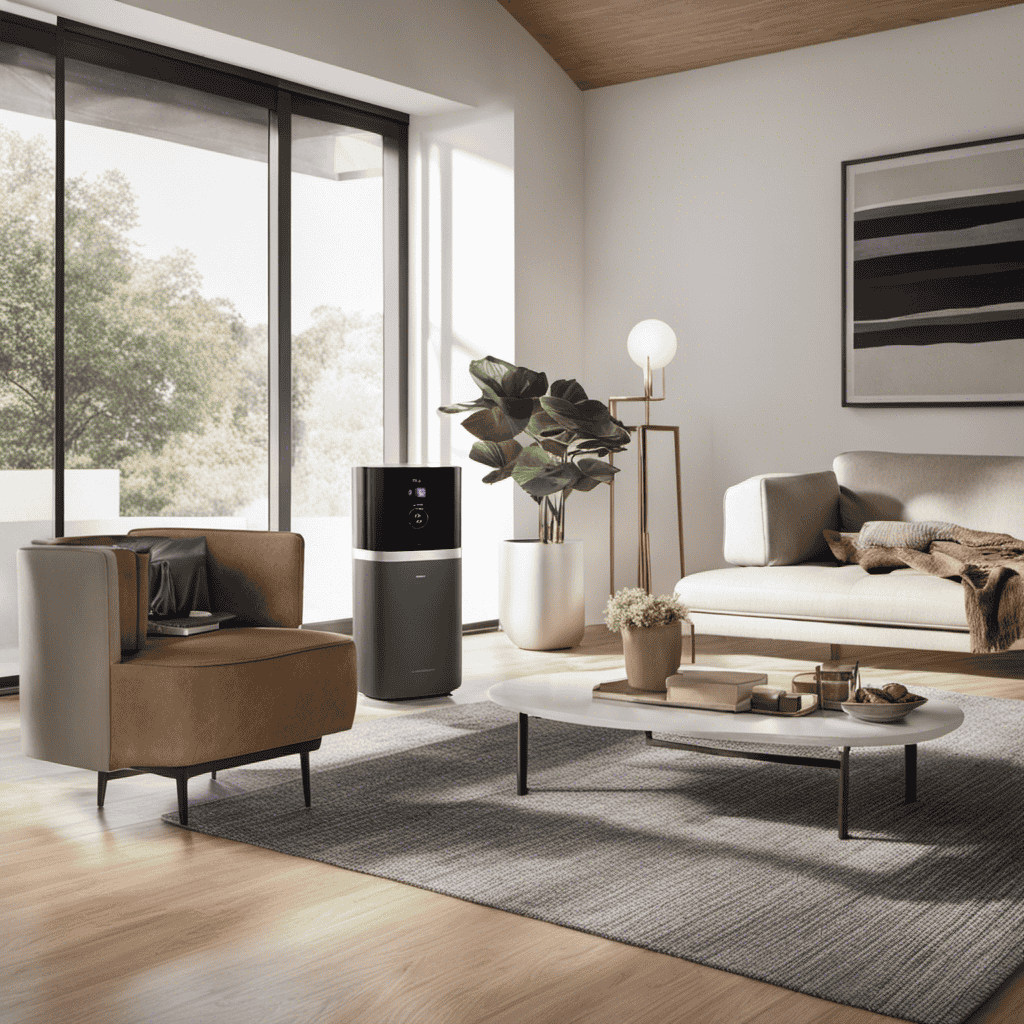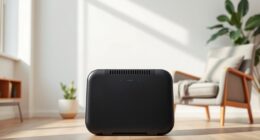Ozone-generating air cleaners are not recommended because they produce harmful ozone, which can damage your lungs and worsen respiratory issues like asthma. Ozone reacts with indoor chemicals, creating secondary pollutants that can irritate your airways and cause coughs, throat discomfort, and chest tightness. Many health organizations warn against using these devices indoors, especially around vulnerable groups. To learn safer ways to improve your indoor air quality and protect your health, continue exploring this important topic.
Key Takeaways
- Ozone generators produce harmful ozone, which can irritate lungs and worsen respiratory conditions like asthma.
- Ozone reacts with indoor chemicals, creating secondary pollutants such as formaldehyde and fine particulates.
- Regulatory agencies warn against using ozone-based air cleaners indoors due to health risks.
- Safer air purification options like HEPA and activated carbon filters effectively improve air quality without ozone.
- Ozone generators are ineffective at removing most indoor pollutants and pose significant health hazards.
What Are Ozone-Generating Air Cleaners?
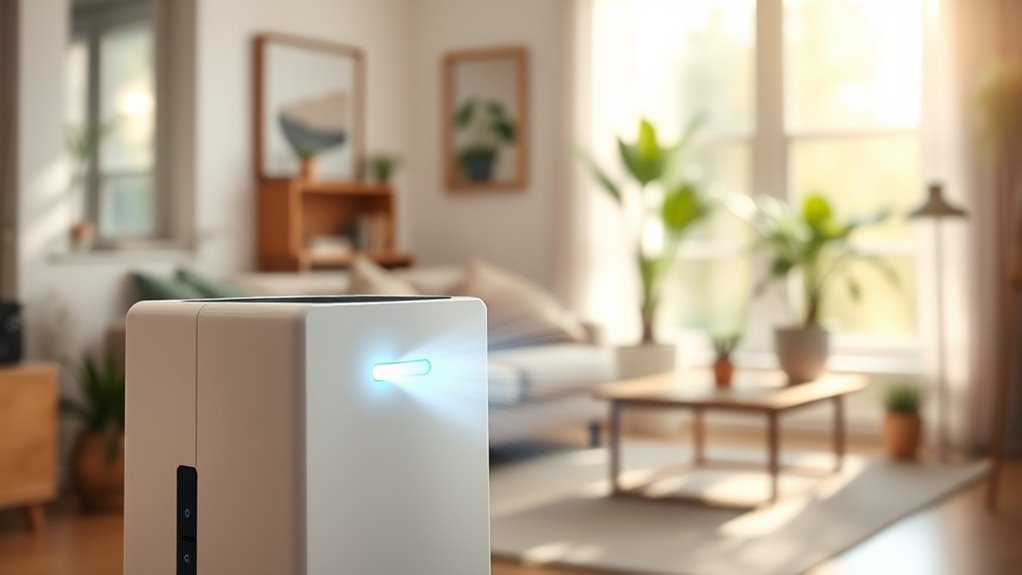
Ozone-generating air cleaners are devices designed to remove airborne pollutants by producing ozone, a reactive form of oxygen. Many people believe these air purifiers effectively eliminate odors and bacteria, but there are significant air purifier myths surrounding their safety and effectiveness. Ozone safety is a major concern because high ozone levels can irritate your lungs and worsen respiratory issues. Despite claims that these devices are safe when used properly, experts warn that ozone can cause health problems, especially in enclosed spaces. It’s important to understand that ozone doesn’t selectively target pollutants; instead, it reacts with everything in the air, which can create harmful byproducts. Recognizing these facts helps you avoid misconceptions and make informed decisions about air cleaning options, especially considering the effectiveness of ozone in air purification and potential health risks. Additionally, the potential health hazards associated with ozone exposure have been well documented by health authorities. A better understanding of chemical reactions in the air reveals how ozone interacts with various substances, often producing undesirable compounds. Many studies also highlight the limitations of ozone-based cleaners, emphasizing that they are not a safe or reliable method for improving indoor air quality. Moreover, the rise in e-commerce sales of air purifiers indicates a growing consumer interest, underscoring the need for awareness about their actual safety and efficacy.
How Do These Devices Work?
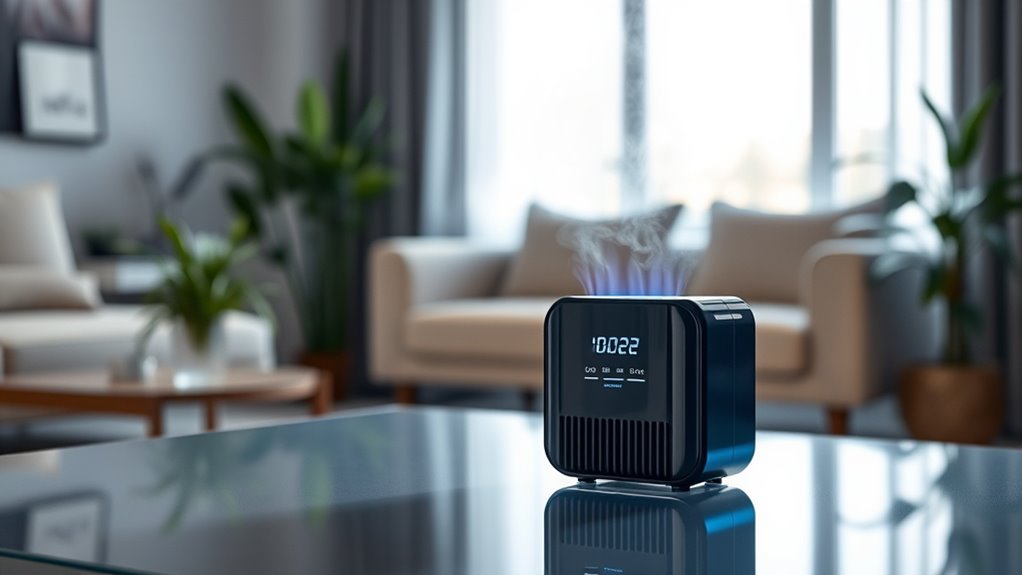
These devices work by producing ozone through electrical or chemical processes, which then reacts with airborne pollutants. This process relies on ozone chemistry, where ozone molecules break down pollutants into less harmful substances. In air purification, the device generates ozone intentionally, hoping it will neutralize odors, bacteria, and other contaminants. The ozone reacts with volatile organic compounds (VOCs), bacteria, and mold spores, converting them into simpler compounds like carbon dioxide and water. However, while this may sound effective, the ozone quickly disperses throughout the space, often reacting with other indoor chemicals. This method of air cleaning is not selective and can create secondary pollutants. Understanding how these devices operate highlights why relying on ozone for air purification can be problematic and why safer alternatives are recommended. Additionally, improper use of ozone generators can lead to increased indoor chemical reactions, further compromising air quality. The potential for secondary pollution underscores the importance of choosing safer air purification methods. Safe air purification methods typically avoid generating ozone, reducing the risk of additional indoor pollutants.
The Health Risks Associated With Ozone Exposure
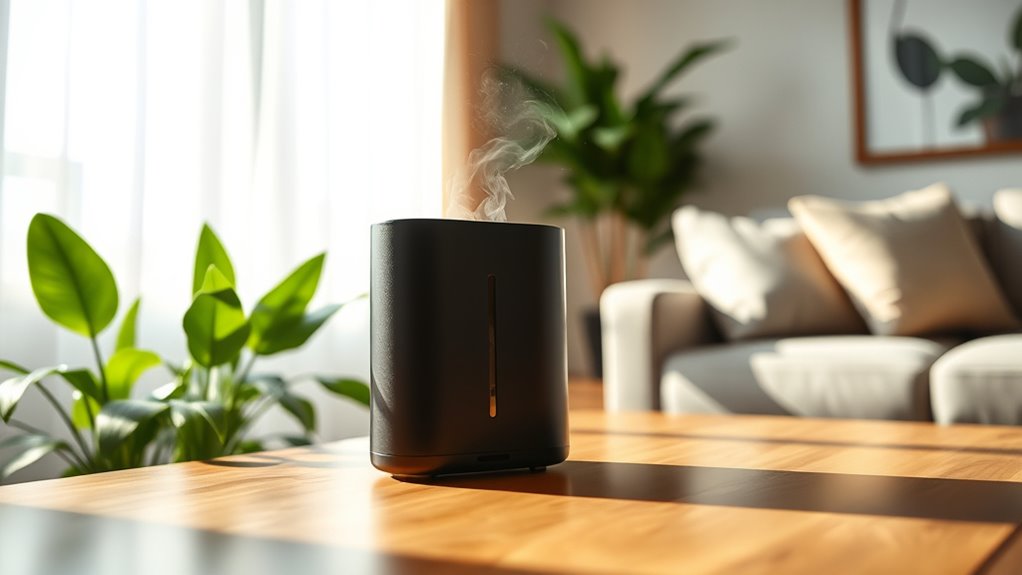
When you use ozone-generating air cleaners, you risk irritating your respiratory system, leading to coughing or throat discomfort. Prolonged exposure can also cause more serious long-term health issues, especially for vulnerable groups. It’s important to understand these dangers before relying on such devices for cleaner indoor air. Additionally, the oxidative effects of ozone can damage lung tissue and exacerbate existing respiratory conditions. Awareness of the air purification process helps consumers make safer choices. Moreover, understanding the vibrational impact of ozone exposure can further inform health-conscious decisions. Recognizing the projector technology behind ozone production can aid in avoiding devices that emit harmful levels of ozone.
Respiratory Irritation Risks
Exposure to ozone from air cleaners can cause immediate and noticeable respiratory irritation, especially for sensitive individuals. Breathing in ozone can inflame your airways, leading to coughing, throat irritation, or chest discomfort. When indoor humidity levels fluctuate, these effects can worsen, trapping pollutants and increasing irritation risks. Ozone exposure may also trigger allergic reactions, making symptoms like wheezing or shortness of breath more severe. People with asthma or respiratory conditions are particularly vulnerable. Even short-term exposure can cause discomfort and exacerbate existing breathing problems. Because ozone irritates the respiratory tract directly, avoiding devices that produce ozone is essential. Instead, focus on maintaining proper indoor humidity and using safer, non-ozone generating air purification methods to protect your respiratory health. Additionally, understanding the respiratory irritation risks associated with ozone exposure can help you make informed decisions about air quality management. Ensuring proper air filtration methods that do not produce ozone can significantly reduce these health risks. Regularly monitoring indoor humidity levels can further help minimize irritation and pollutant buildup. Incorporating HEPA filtration into your air quality strategy offers an effective way to improve air purity without ozone-related hazards. Being aware of the Glycolic Acid Benefits for Skin can also help you optimize skincare routines that support overall health and well-being.
Long-term Health Effects
Prolonged inhalation of ozone can lead to serious long-term health problems, especially for individuals with pre-existing respiratory conditions. Long-term exposure to ozone increases the risk of developing chronic health issues, such as persistent airway inflammation and reduced lung function. Over time, these effects can worsen, causing ongoing breathing difficulties and increasing vulnerability to respiratory infections. Continuous ozone exposure may also contribute to the development of conditions like asthma or exacerbate existing symptoms. Because ozone is a strong oxidant, it damages the delicate tissues in your lungs with repeated exposure. Sound design techniques can be used to create effective alternatives to ozone-generating devices that do not pose health risks. Avoiding ozone-generating air cleaners helps prevent these long-term health risks, protecting your respiratory system from the cumulative effects of chronic health problems caused by repeated ozone inhalation. Additionally, understanding the health risks associated with ozone emphasizes the importance of choosing safer air purification methods to safeguard long-term respiratory health. Implementing non-ozone air purification options can significantly reduce the risk of lung tissue damage and improve overall indoor air quality. Recognizing the dangers of ozone highlights the necessity of informed decisions when selecting air cleaning technologies. Moreover, selecting air purifiers without ozone can help minimize exposure and promote healthier indoor environments.
Why Ozone Can Be Harmful to Respiratory Health
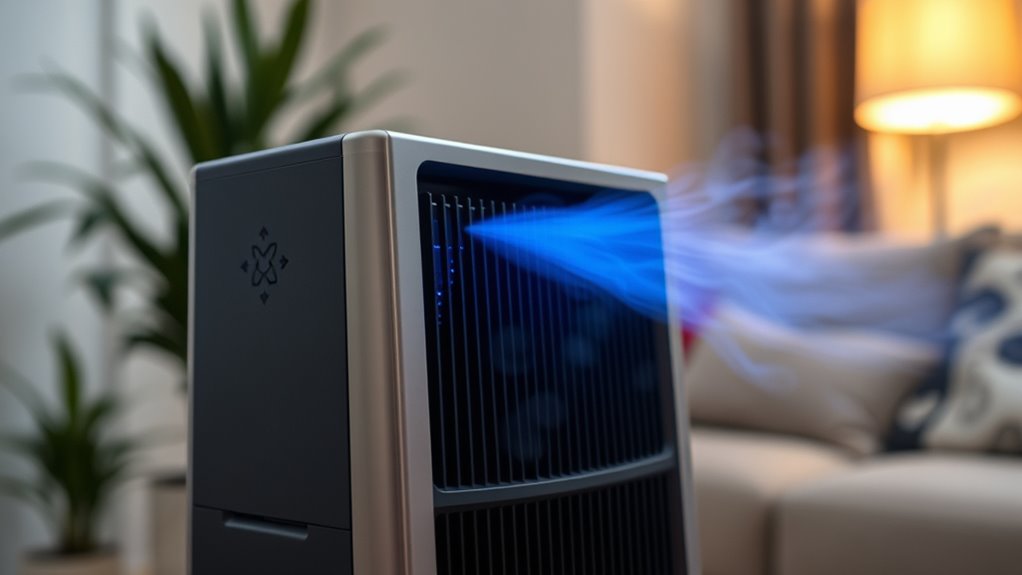
Ozone can harm your respiratory health by irritating your lung tissue, which may cause discomfort or breathing problems. It can also worsen asthma symptoms, making it harder to breathe and increasing your risk of attacks. Additionally, ozone produces harmful byproducts that can further damage your respiratory system over time. Vetted Halloween Product Reviews highlight the potential dangers of using ozone-generating air cleaners. Since ozone can also contribute to air pollution, it can have broader negative effects on overall environmental health. Moreover, the production of ozone during use can lead to indoor air quality deterioration, further impacting respiratory well-being. Understanding the impact of cookies on user experience helps emphasize the importance of avoiding harmful substances like ozone in your indoor environment. Recognizing the market volatility and trends in related industries underscores the importance of choosing safer air purification options.
Irritates Lung Tissue
Because ozone is a highly reactive gas, it can quickly irritate the delicate tissues in your lungs when inhaled. This irritation leads to inflammation, making your airways feel sore or raw. Over time, repeated exposure can cause airway damage, weakening your lung tissue and reducing your ability to breathe comfortably. You might notice coughing, chest tightness, or shortness of breath as your body reacts to the ozone’s presence. Since ozone doesn’t just stay in the air but interacts with your respiratory system, it can worsen existing lung conditions or contribute to new issues. Cybersecurity vulnerabilities during the use of ozone-generating air cleaners highlight the importance of opting for safer alternatives. Additionally, exposure to ozone can exacerbate symptoms in individuals with pre-existing respiratory conditions, emphasizing the need for safe air quality solutions. Avoiding ozone-generating air cleaners helps protect your lungs from unnecessary irritation and long-term damage, supporting healthier, clearer breathing.
Exacerbates Asthma Symptoms
The irritation caused by ozone in your lungs doesn’t just stop at soreness or inflammation; it can considerably worsen asthma symptoms. When your air quality is compromised by ozone, your airways become more sensitive and prone to bronchospasms. Even if you have indoor plants that improve air quality, ozone can still trigger asthma attacks. Ozone particles irritate the lining of your respiratory system, making it harder to breathe and increasing the frequency of asthma flare-ups. This is especially risky if you already have asthma or respiratory issues. Instead of relying on ozone-generating air cleaners, opt for better ventilation and air purifiers that do not produce harmful ozone. Protecting your respiratory health means avoiding sources that worsen airway inflammation.
Produces Harmful Byproducts
While ozone itself can irritate your lungs, its dangers extend beyond that, as it reacts with other substances in the air to produce harmful byproducts. When ozone interacts with indoor pollutants like volatile organic compounds (VOCs), it creates secondary pollutants such as formaldehyde and fine particulates that can worsen respiratory issues. Even if you have indoor plants, which improve air quality through natural air exchange, ozone can still produce these harmful compounds. These byproducts can penetrate deep into your lungs, causing inflammation and irritation. Relying on ozone-generating air cleaners may give a false sense of cleaner air while actually introducing more health risks. It’s safer to use ventilation and air filtration systems that don’t produce harmful byproducts, especially if you’re concerned about respiratory health.
Regulatory Stances and Safety Warnings
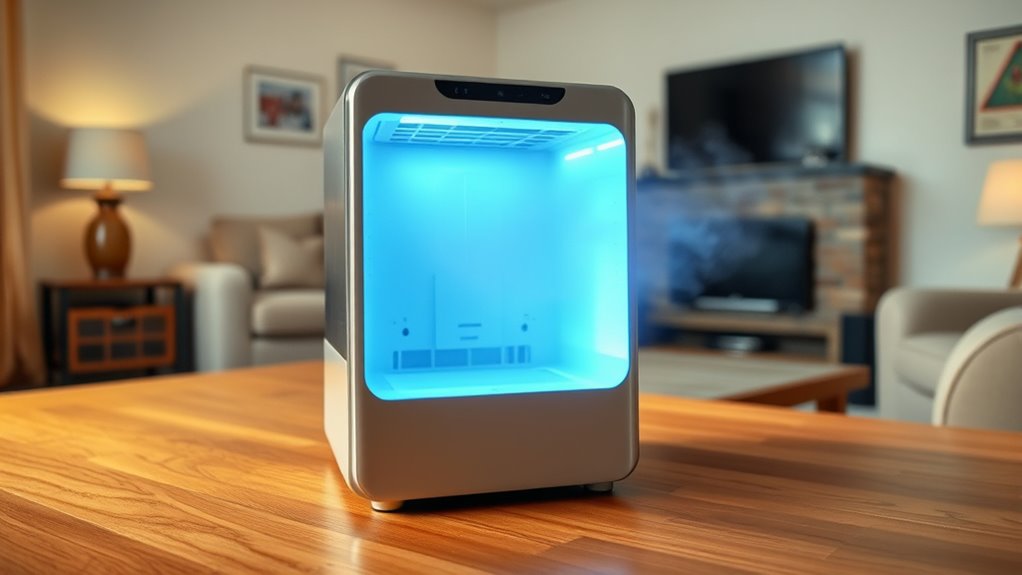
Have regulatory agencies issued clear guidelines or warnings about ozone-generating air cleaners? Yes, they have, primarily through safety warnings and regulatory bans. Agencies like the EPA and FDA emphasize ozone’s health risks and restrict certain uses. Here’s what you should know:
- Many agencies have issued safety warnings advising against using ozone generators in occupied spaces due to respiratory risks.
- Several countries have implemented regulatory bans on ozone-generating air cleaners, citing their potential to produce harmful byproducts.
- Manufacturers face strict regulations, requiring clear labeling and warnings to inform consumers about ozone levels and health hazards.
These measures aim to protect public health by discouraging the use of devices that can cause more harm than good.
Alternatives to Ozone-Based Air Purification
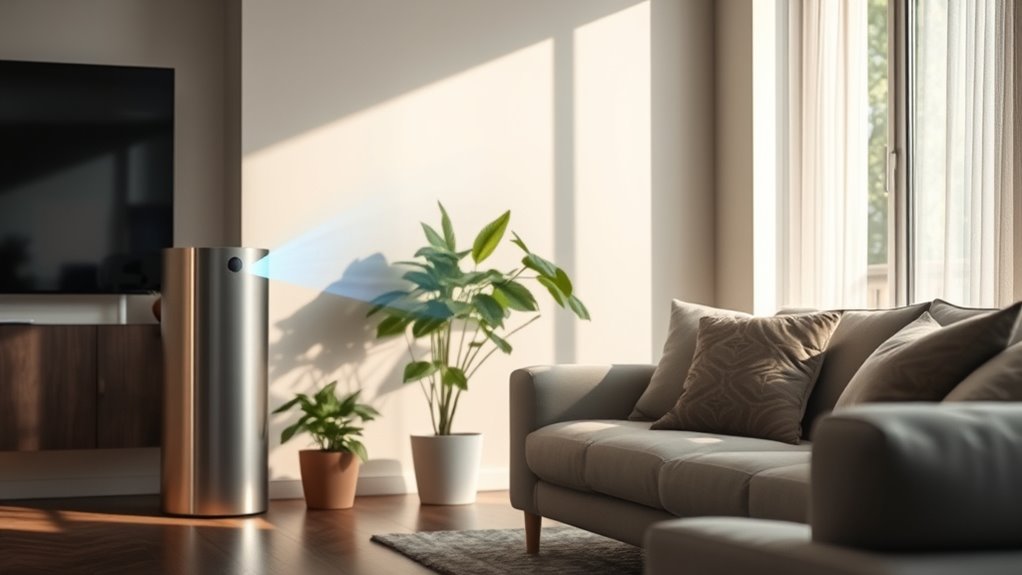
Are there safer and more effective alternatives to ozone-based air purifiers? Absolutely. Many people fall for air purifier myths, believing ozone alternatives are less effective. In reality, HEPA filters and activated carbon filters offer proven benefits without harmful emissions. These devices trap particles and absorb odors, improving indoor air quality safely. Consider this comparison:
| Feature | Ozone Alternatives | Ozone-Based Purifiers |
|---|---|---|
| Safety | Non-toxic, no harmful gases | Potential ozone emission |
| Effectiveness | Proven for particles and odors | Less proven, safety risks |
| Maintenance | Regular filter replacement | Often more complex |
Switching to HEPA and activated carbon filters provides cleaner, safer air without the risks linked to ozone generators.
Proven Methods for Improving Indoor Air Quality
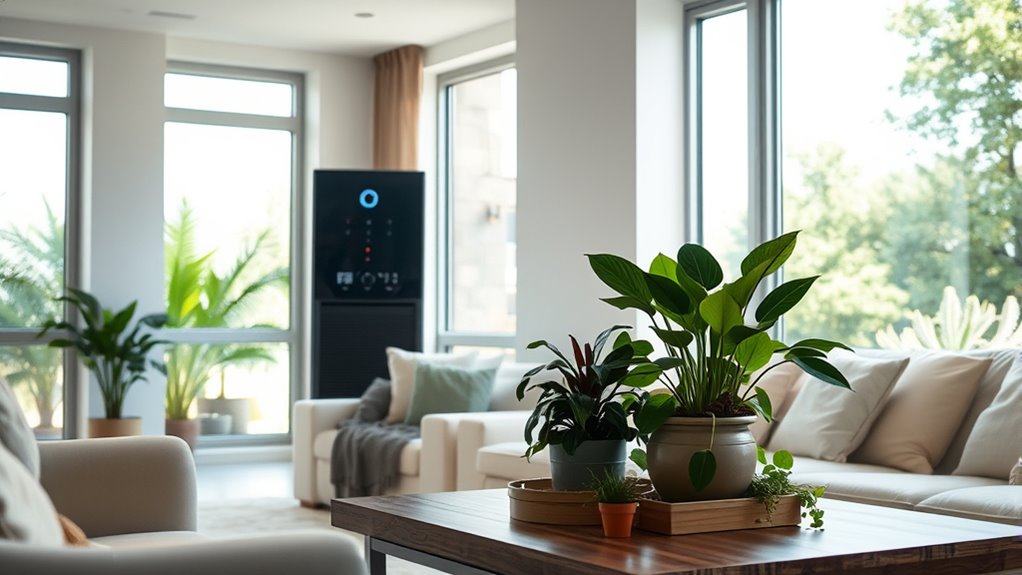
To improve indoor air quality effectively, focus on increasing ventilation and airflow throughout your space. Implement source control strategies by removing or reducing pollutants at their origin, and consider using HEPA filters to capture airborne particles. These proven methods work together to create a healthier indoor environment.
Ventilation and Airflow
Ever wondered how proper ventilation can dramatically improve indoor air quality? It all comes down to effective air exchange and understanding airflow dynamics. Good ventilation replaces stale air with fresh outdoor air, reducing pollutants and humidity. To optimize this, consider these key points:
- Guarantee continuous air exchange by opening windows or using mechanical systems.
- Use exhaust fans in kitchens and bathrooms to remove contaminants.
- Maintain proper airflow patterns to prevent stagnation and promote even distribution of fresh air.
Source Control Strategies
Have you considered that controlling the sources of indoor pollutants is one of the most effective ways to improve air quality? By addressing the root causes, you reduce the need for relying on air purifier myths or questionable ozone efficacy. For example, minimizing smoking indoors, fixing leaks that cause mold, and choosing low-emission cleaning products can markedly cut pollutants. Source control doesn’t depend on devices that produce ozone, which can worsen indoor air quality. Instead, it involves practical steps that prevent pollutants from accumulating. This approach often yields better results than air purifiers claiming to eliminate contaminants through ozone. Remember, focusing on source control is a proven strategy that makes your indoor environment healthier and safer without the risks associated with ozone-generating cleaners.
Use of HEPA Filters
Using HEPA filters is one of the most effective ways to improve indoor air quality because they can capture tiny particles that other filters often miss. These filters excel at removing allergens, dust, and airborne pollutants, enhancing overall air filtration. To maximize their benefits:
- Choose a HEPA-filtered air purifier suitable for your room size.
- Regularly replace or clean the filters as recommended by the manufacturer.
- Position the purifier in high-traffic areas for best air circulation.
Common Misconceptions About Ozone Air Cleaners

Many people believe that ozone air cleaners are completely safe and effective for removing indoor odors and pollutants. This is a common misconception myth. Many assume that since ozone occurs naturally, using these air cleaners poses no safety concerns. However, the truth is that high ozone levels can cause health problems, especially for sensitive individuals. Some think that ozone only reacts with odors, but it can also irritate your lungs, throat, and eyes. Safety concerns are often overlooked because manufacturers sometimes downplay risks or claim ozone is harmless at certain levels. In reality, even low doses can be harmful over time. It’s important to understand these misconceptions so you can make informed decisions about indoor air quality and avoid unnecessary health hazards.
The Impact of Ozone on Sensitive Populations

While misconceptions about the safety of ozone air cleaners persist, it’s important to recognize how these devices uniquely affect vulnerable groups. Sensitive populations, such as children, the elderly, and those with respiratory conditions, face increased ozone health risks. Exposure can worsen asthma, cause lung irritation, and reduce lung function. Specifically:
- Children’s developing lungs are more susceptible to ozone damage.
- The elderly may experience heightened respiratory distress.
- People with existing health issues face more severe ozone health risks.
These impacts highlight why ozone’s effects on sensitive population impacts are serious. If you or loved ones belong to these groups, using ozone-generating air cleaners can pose significant health dangers. Protecting vulnerable individuals requires understanding these risks and avoiding devices that emit ozone.
Making Safer Choices for a Healthier Indoor Environment
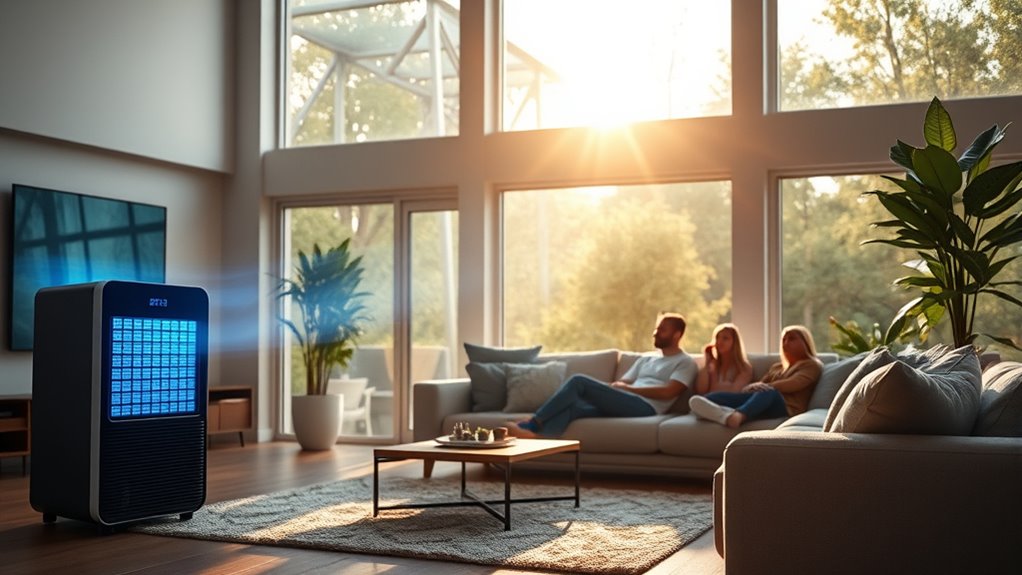
To create a healthier indoor environment, you need to choose air cleaning options that minimize health risks, especially for vulnerable populations. Start by understanding air purifier facts instead of falling for ozone myths. Many believe ozone generators are effective air cleaners, but research shows they can produce harmful ozone levels that irritate lungs and worsen respiratory conditions. Instead, look for HEPA filters or activated carbon filters, which safely remove pollutants without creating dangerous ozone. Always check product labels and certifications to ensure your air purifier is safe and effective. Making informed choices helps protect your health and ensures a cleaner, safer indoor space. Remember, safer options exist that prioritize your well-being without risking ozone exposure.
Frequently Asked Questions
Can Ozone Generators Eliminate All Indoor Pollutants Effectively?
Ozone generators don’t effectively eliminate all indoor pollutants. Instead, they can worsen indoor air quality by producing ozone, which irritates your lungs and reacts with pollutants to create harmful byproducts. While they might remove some odors, they don’t provide thorough pollutant removal. For better indoor air quality, opt for HEPA filters or ventilation systems that actively clean the air without risking your health.
Are There Any Safe Levels of Ozone Exposure for Humans?
Did you know that the EPA’s health guidelines set ozone exposure limits at 0.05 parts per million over 8 hours? There’s no safe level of ozone exposure for humans, as even low levels can cause respiratory issues and other health problems. It’s best to minimize your exposure, follow recommended safety standards, and avoid any ozone-generating devices that could push levels beyond established limits. Your health depends on it.
How Do Ozone Generators Compare to HEPA Filters?
When comparing ozone generators to HEPA filters, you’ll find HEPA filters are more effective at capturing particles and allergens without producing harmful byproducts. Ozone effectiveness is questionable since it doesn’t directly remove particles and can cause health issues. HEPA filters are safer for indoor air quality, while ozone generators often pose risks due to ozone’s irritant properties. Overall, HEPA filters are the better, safer choice for clean air.
Are Ozone Air Cleaners Legal to Sell and Use Everywhere?
Think of ozone air cleaners as wild horses—powerful but hard to control. You might wonder if selling or using them is legal everywhere. In many places, strict legal restrictions and regulations govern their sale and use, often due to health concerns. You need to verify local laws for regulatory compliance, as some regions ban or limit these devices. Always make certain you’re following legal guidelines to avoid penalties and protect your health.
What Are the Long-Term Health Effects of Chronic Ozone Exposure?
Chronic ozone exposure can cause serious health problems over time. You might experience lung irritation and worsening respiratory issues, especially if you’re exposed regularly. Ozone can inflame your airways, making breathing difficult and increasing the risk of infections. Long-term exposure can also contribute to the development of chronic respiratory diseases. To protect your health, avoid sources of prolonged ozone exposure and opt for safer air purification methods.
Conclusion
When it comes to improving your indoor air, don’t fall for the trap of ozone-generating cleaners. They may seem like a quick fix, but they can do more harm than good, especially if you’re sensitive or have respiratory issues. Stick to proven methods like good ventilation and air purifiers without ozone. Remember, it’s better to be safe than sorry—sometimes, the best solution is to play it safe and keep your health front and center.
